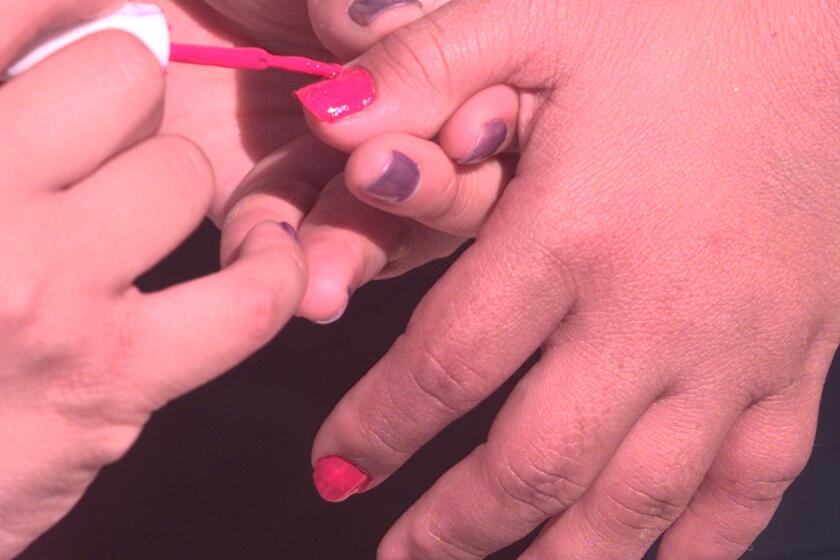Why are school districts still using dress codes to discriminate against girls?

- Share via
A few months ago, someone scrawled this provocative message on the wall of a girls’ bathroom stall at a high school in Corona: “I can get sent home for a tank top, but a guy can sexually assault me on campus and nothing happens.”
I wasn’t surprised when my daughter, a high school sophomore, showed me a photo of the note. For months, I’d been hearing how she and her female friends felt vulnerable to the whims of school staff inspecting and commenting on their clothing and bodies as they enforced the dress code every day. Meanwhile, my older son and his male friends breezed through four years of high school without feeling overly scrutinized by school officials.
As it turns out, students at other schools nationwide have similar experiences. An investigation by the U.S. Government Accountability Office late last year revealed that many school dress codes have created unsafe and inequitable conditions, possibly violating students’ civil rights that guarantee equal treatment. And the Supreme Court is considering weighing in on a 2019 ruling in the 4th Circuit Court striking down a North Carolina charter school’s requirement that girls must wear skirts or dresses. Students at the school say the requirement is discriminatory and conveys the message that girls are inferior to boys.
Banned Books Critical Race Theory Censorship
As parents, we expect that our sons and daughters will be treated equally if they attend a public school as is guaranteed by the Equal Protection Clause of the 14th Amendment to the Constitution and Title IX, a federal civil rights law that prohibits discrimination in schools or education programs that receive federal funding. Yet girls are often unfairly targeted by school administrators nationwide enforcing sometimes arbitrary dress restrictions.
California and other states give local districts wide latitude in creating and implementing dress codes to promote school safety and discipline. California’s Education Code, for example, specifically cites “gang regalia” in the section granting schools the right to set rules regarding dress.
School districts regulate far more than potential gang-related clothing, with rules stipulating, for example, that leggings can be worn only with a skirt, dress or long shirt and specifying the length of skirts, tops and dresses. Dress codes skirt laws against discrimination by regulating items of clothing for all students rather than creating separate rules for girls and boys. Many administrators have the right to send students home, or potentially suspend them, if students are wearing clothing they consider inappropriate.
Mental health issues for young people are concerning, but schools monitoring their online activity is an invasive response
At my kids’ high school, the scrutiny starts at the school gates. The mostly male security guards assess girls’ outfits, especially their tops, as they walk by. Among the prohibited clothes are spaghetti straps, tank tops, crop tops and low-cut tops. Some girls are told to zip up their sweatshirts, if they’re wearing one. Others are taken to the main office to talk to a vice principal and for possible disciplinary action. One teacher tells girls in her class who are wearing crop tops not to “dress like prostitutes.”
Treating students in such dehumanizing ways has no place in any school. However, according to the GAO, almost half of all public schools nationwide enforce a strict dress code, and these policies tend to include more rules for girls than boys. Moreover, the GAO found that schools with higher percentages of Latino and Black students are more likely to enforce strict dress codes.
The latest national proficiency test scores offer a desolate picture of students’ academic achievement, showing that we need immediate action to fix the learning loss. But there are pockets of hope, among them reading scores for LAUSD eighth-graders.
Civil rights groups have been fighting school dress codes in several states in recent years. In one such case in Florida, the American Civil Liberties Union in 2018 accused Manatee School District officials of violating the rights of Lizzy Martinez, a high school student disciplined for not wearing a bra under her shirt due to a painful sunburn. An administrator required Martinez to wear Band-Aids as a substitute, then asked her to “stand up and move around” while looking at her chest.
An ACLU spokeswoman explained that school dress codes are problematic because there is so much variation in how policies are worded and how they’re enforced. Too often, the codes promote sexist stereotypes and disproportionately affect groups based on their ethnicity, religion or cultural identity. In Caldwell, Idaho, Latino community leaders claim a local school dress code unfairly affects Latino students because a student was asked to remove or turn inside out her sweatshirt with the words “Brown Pride.”
The Los Angeles Unified School District allows its schools to create their own dress codes, though it does require that they be gender neutral and align with the district’s policy. However, not all of them do. For example, Garfield Senior High School bans clothing items that include “revealing or low cut tops” and warns that students could be sent home for violations.
Texas schools’ attempts to crack down on students for gender-defying appearances make clear the need for schools to end discriminating dress codes.
Despite so many publicized cases and complaints, school districts continue to enforce unfair rules. Following the GAO investigation, the U.S. Department of Education agreed to draft guidelines to prevent illegal discrimination based on dress codes. In addition, federal education officials are currently requesting public input on the types of informal removals and other such data to determine how to word questions for a future study to gauge how often students are losing class time for these violations.
As a parent, I believe that such emphasis on girls’ outfits is harming the learning environment. At a time when many students are struggling with mental health issues and pandemic-induced learning difficulties, administrators should be using their time to help students with their academics, not causing them to lose class time over discriminatory dress codes. School districts should revise these rules — or dump them.
More to Read
A cure for the common opinion
Get thought-provoking perspectives with our weekly newsletter.
You may occasionally receive promotional content from the Los Angeles Times.














